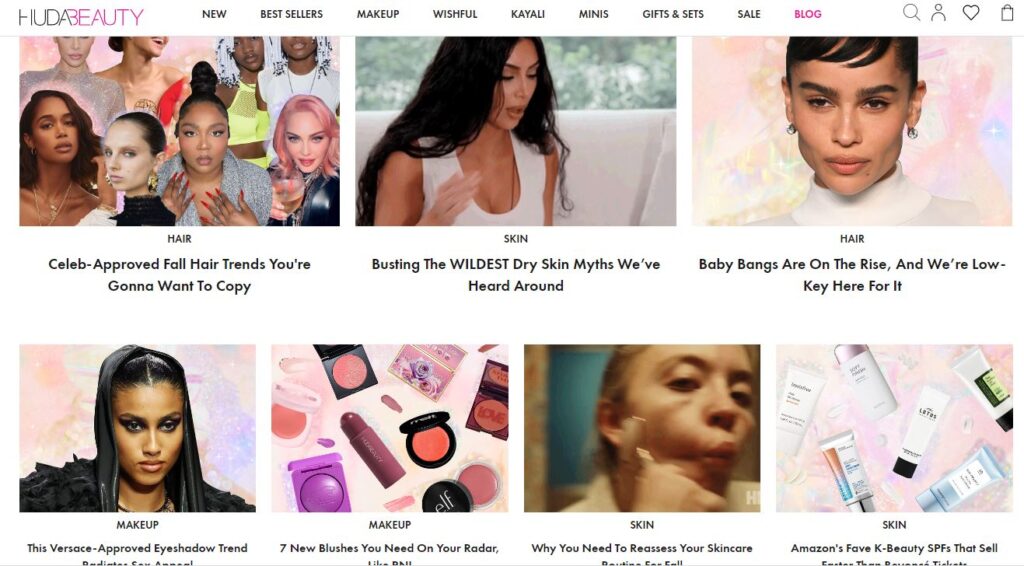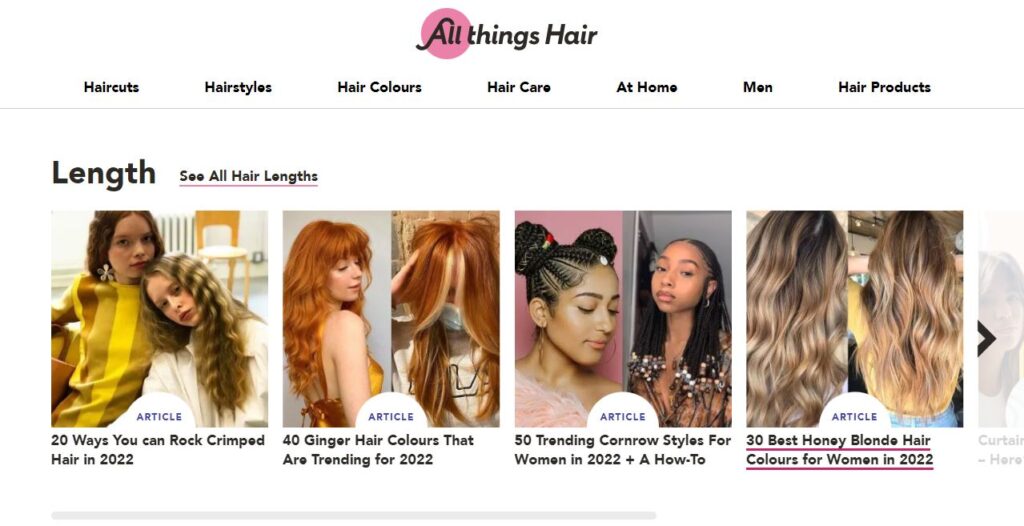A content hub is a curation of content on a specific topic or subject which includes articles, as well as videos, image galleries, infographics, social posts and other forms of content. It aims to provide a deep dive into the information that your target audience needs, whatever format it comes in.
Rather than sitting under the blog section of the website, this content sits in it’s own dedicated ‘hub’ — i.e. a website subdirectory or even its own microsite — for that specific topic.
It’s usually smaller than a website, but bigger than a blog and contains different types of content. Not just one type.
Why is a content hub a good idea?
When it comes to Google’s Helpful Content update, a content hub can be a great idea as it provides useful information for your target audience or ideal customer. It also establishes you as an expert and voice of authority in your chosen area as well as inspiring your audience to engage.
Plus, content hubs look good as they mix visuals with written content, social content, user-generated content and more. They can be way more interesting and engaging than just words on a page.
A content hub helps you to categorise and structure your content in a way that works for SEO. It also allows you to crosslink and signpost users to other pieces of content on site. This means that Google starts to build up a picture of what your site’s about, why it’s useful and who’s likely to be reading it.
Through this SEO-led approach, you gain gain traffic and activity on your site. Which is kind of the whole point. Whether your end goal is sign-ups, sales or something else, getting visitors to your website is usually the first step.
It’s also circular, as by checking out the analytics you have on site you can start to build up a picture of how people engage with your site, any information gaps and areas to improve.
A content hub is also an “owned” channel. It’s all yours. You own it and control what appears on it and how it appears. Social media platforms are forever changing, and you’re building a community on a channel that isn’t actually “yours” as a brand – you’re almost just renting space. A change in the algorithm or approach and it could all be gone overnight.
Beauty brand content hubs
Need some inspiration on what a beauty brand content hub might look like? Don’t worry, I’ve got you covered. Here are some beauty brands who have taken a content hub approach and seen results.
Huda Beauty

This one blends the boundary between blog and content hub a little, but I’d argue that this is definitely on the way to becoming a content hub (even if it technically is titled as a blog).
Huda Beauty has taken topics that their target audience are interested in, done their keyword research and totally gone for it. They share content on wellness, hair, beauty, skincare, makeup and a few other things in between, blending trends and SEO for content that ranks.
This approach attracts people to the site, keeps them engaged and encourages them to stick around and browse some products. This starts to build a brand experience for potential customers, with it feeling useful rather than overly salesy.
All Things Hair
All Things Hair turned its successful YouTube channel into a content hub. It’s owned by Unilever, but it doesn’t necessary look like that as they’ve mimicked the style of a beauty blog and YouTube channel across hundred of videos and thousands of articles.
They’ve blended trends with SEO across 11 global markets, multple languages and 64 Unilever hair care brands, with countless products and cross linking opportunities. Plus the content can be filtered to provide a great user experience – other content is also crosslinked and recommended throughout.
Over 10,000 hair care and style terms currently rank in the top 10 positions on Google for All Things Hair and they achieve 39.7 million sessions of organic traffic in 2020.
Sephora x Complex: Beauty Beyond The Surface

While this hasn’t launched fully yet, it’s worth mentioning because it’s so huge. Complex (owned by Buzzfeed) and beauty behemoth Sephora are going to be creating a content hub that shares weekly content over a six month period.
Called Beauty Beyond The Surface, the space has been created for BIPOC women where their beauty and style questions can be honestly answered. It’ll feature editorials and video focused on people in streetwear and sneaker space with content ranging from “beauty moments in hip hop, to stories about protective hairstyles.”
Watch this space.
How to build a content hub
The way you build a content hub will depend on what your goals are as a brand and your current set up, but there are a few things that you need to build a content hub for your beauty business.
- A plan – you need to think about what you’re going to write about, how it’s going to be structured, how often you’re going to publish and who your target audience is as a starting point. You also need to work out if you’re also going to write about adjacent topics, or just stick to your main one.
- A platform – if you don’t already have a platform, you need to decide how you’re going to set this up and what you’re going to publish content on. Sense check that it has all of the functionality that you need too, though must publishing platforms enable you to publish a variety of different media.
- Research and insights – for a successful content hub you need to understand your audience, what motivates them and why they’d be reading your content. You also need some keyword and topic research, and as time goes on some analytics to discover what’s working and what isn’t.
- Expertise – it goes without saying that your content needs to be accurate, useful and informative. That usually comes with a certain level of expertise or topic knowledge. that demonstrates that you’re a voice of authority on a certain topic.
- Content – one of the final (and arguably most important) step is to create the content and publish it to your content hub. This includes content creation, SEO where appropriate and editing. Your content needs to add value to the reader and be well-written.
- Distribution strategy – it’s not always a case of “if you build it they will come”, even with SEO and top tier content. You need a content distribution strategy to make sure your content is seen by your target audience.
Need help with creating your a content hub for your beauty brand?
Get in touch with me to find out how working with a beauty content writer (that’s me) can help you create a content hub to connect with your audience.


